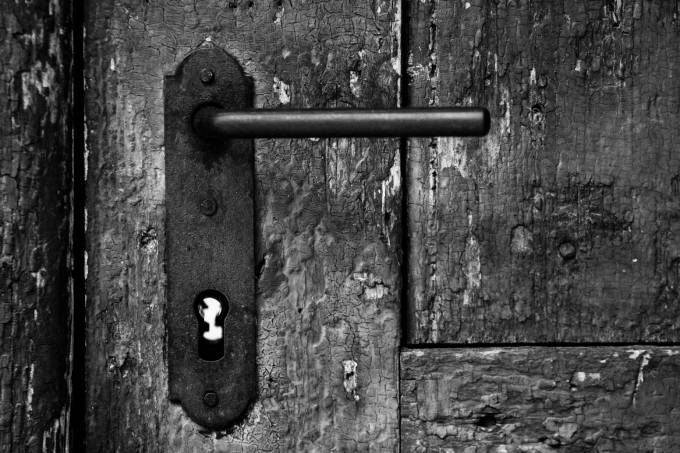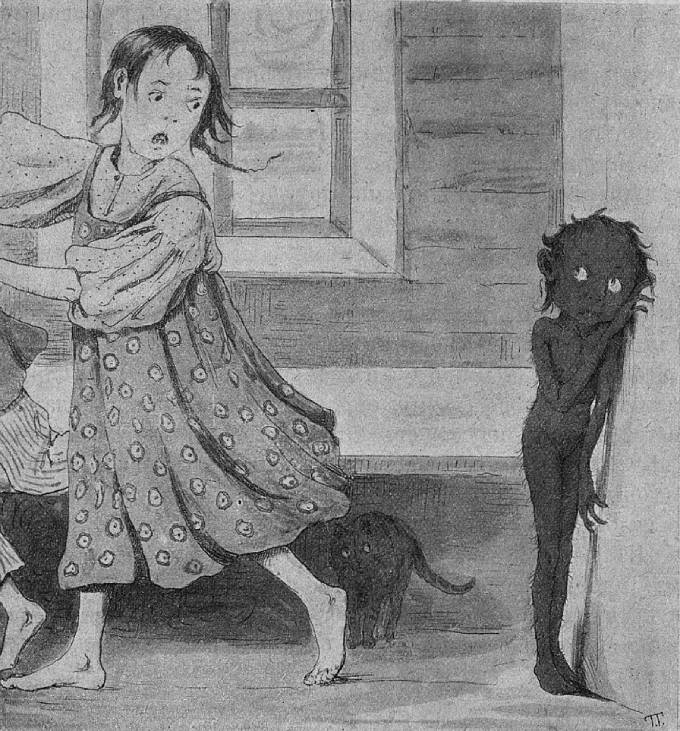Kikimora is a female house spirit of Slavic origin. She is the explanation for sleep paralysis in Russian folklore and all that goes ‘bump’ in the night.
Kikimora inhabits the smallest of places and darkest of corners. She terrorizes households and brings them bad luck, leaving wet footprints wherever she goes. Kikimora wreaks havoc in the lives of both humans and animals alike.
The legend of Kikimora
Kikimora (or Kikimory – plural) made her first TV debut in the opening scene of the TV show The Witcher in 2019. However, the eight legged-beast slain by Geralt of Rivia within the first 5 minutes of the show was not a fantastical creature dreamt up by screenwriters, but based on the legendary creature Kikimora, an ancient fairy tale figure with origins in Slavic folklore dating back to somewhere between the 8th and 13th centuries.
Kikimora is a female demon said to be born from spirits of unbaptized infant girls or the offspring of a fiery serpent. She is a humanoid figure inhabiting homes built on top of burial grounds, or she is sent by an evil witch or sorcerer looking to cause chaos. Kikimora can also be summoned by a disgruntled contractor (more on that later).

The word Kikimora is believed to derive from the Finno-Ugric languages that stretched from the Baltic Sea to the Ural mountains in Russia. The term ‘Kikka-murt‘ means bag-made person or scarecrow, which more accurately describes the Slavic Kikimora, who looks like a spindly old-hag rather than a giant swamp-dwelling arachnid as depicted in The Witcher.
The Proto-Slavic word mora means ‘nightly spirit’ or ‘bad dream.’ Mora was also a type of lucid dream, whereby the souls of living people could be seen floating out of their bodies like wisps of air while they slept and traveled about during the night.
In Croatia and Serbia, Kikimora was a dark, feminine demon who visited men in the night and strangled them, or a spindly witch who lived behind the stove. She is held responsible for every catastrophe that befalls the household. She has an affinity with chickens and loves to spin thread.
There are multiple theories as to the origin of Kikimora. Across cultures and other languages, Kikimora can be a benevolent house spirit or a decrepit monster with evil intentions.
The Kikimory
Kikimory, the plural of Kikimora, comes in many shapes and forms depending on where you are in the world. However, there are two primary types of Kikimory which are more akin to a species rather than a singular creature.
Household spirits
Kikimory that exclusively live in the house are considered female spirits that can be good or evil. A house Kikimora lives behind the stove in the kitchen, basement, or fireplace and makes noises similar to a mouse to attract food.
When Kikimora inhabits a house, she brakes dishes, whistles, and makes noises at night while spinning thread. She is attracted to dysfunctional, unhappy, or abusive families, or can be ‘planted’ there by nefarious home builders looking to beset the new homeowners with bad luck.
Otherwise, when infiltrating a house of her own accord, she enters the home through the keyhole and is very difficult to remove. She sleeps in the dark crevices of the home, and only comes out to attend to her needlework or cause a disturbance.

However, Kikimora is not always that bad. She is a family-orientated spirit, and if she happens upon a happy home, she likes to help out once in a while.
Once nestled inside a happy family, where there is joy and laughter, Kikimora can become attached to the family members and act as their guardian and protector.
She helps with the housework and is particularly fond of taking care of the chickens. She is very protective of hard-working women and matriarchs who keep on top of their traditional ‘wifely’ duties in a cheerful home.
Woodland spirits
The Kikimory living in forests tend to be attracted to swamps and bogs. The wet footprints identify them, which they leave behind when coming and going from the water.
Kikimory of the forests are ugly, disheveled, and bony small dwarf-life creatures. Traditionally they are not large, spider-like monsters with humanoid faces. This depiction of Kikimora (or Kikimore) is drawn from the Slavic legend solely for entertainment purposes. However, in 1988, a real-life spider known as the Kikimora Palustris was named because it too likes to frequent the swampy marshes of Russian forests.
Forest Kikimora like to lure unwitting travelers off-road and drown them. She sometimes kidnaps children who have gone astray, and what happens to the children after she takes them is up for debate.
Physical features and behaviors
From tiny wispy figures no bigger than a straw of hay to dwarf-sized women that infest the deepest of swamps, Kikimory can come in any shape or size.
Swamp Kikimora is usually human or dwarf size (but this can vary) and is almost always a ragged older woman adorned with dead leaves and moss.

Household Kikimora is a much smaller, dark shadowy figure with a beak for a nose (because of her love of chickens), long nails, claw-like hands, and feet. For the most part, depictions of Kikimora tend to be an unpleasant, ghoul-like figure that is the stuff of nightmares.
However, sometimes Kikimora takes the form of a beautiful woman rather than a spindly old lady or creature. She is said to haunt men’s dreams and torture them with their innermost desires, attempting to break down their relationships with real-life women. She would enter women’s dreams too and appear as a young woman. She would stir up images that would incite jealousy and suspicion towards their partners.
She would also take on the form of deceased relatives or a witch. In Slavic culture, Kikimora and witches are closely related, and witches are linked to the creation of Kikimora.
However, in most cases, Kikimora is an old woman blamed for all manner of dire circumstances, from minor daily annoyances to the sudden death of beloved family members—particularly the death of children and babies.
She is also held accountable for missing relatives. If a relative disappears rather than dies, it was assumed that they had been kidnapped by Kikimora of the forests, who were just as likely to take a beloved family member as a member of the family cast out in scorn.
The creation of Kikimora
According to Slavic culture, there is a plethora of Kikimora out there, but how did they get here exactly? Apparently, there are several ways to create a Kikimora.
Death
They say that a Kikimora is born at the birth of every stillborn baby or when an infant dies. She can also be born from the body of a mother who has died during childbirth and will resemble the dead woman upon her creation.
Homebuilding
Another much less morbid way to create a Kikimora is to annoy your builders. Yes, if you irritate, insult or get into your builder’s bad books, this gives your builder the power to create a Kikimora and invite them into your home. So make sure you always pay your contractors on time!
Kikimora in literature
The famous tone poem Kikimora by Anatoly Lyadov attempts to describe the origins of Kikimora. The poem describes Kikimora as an infant in a cradle made of crystal. She is raised by a magician in the mountains, whose cat regales her with stories from ancient times as Kikimora rocks herself to sleep.
In the poem, it takes only seven years for Kikimora to reach maturity, by which time her head is as big as a thimble and her body as wide as a strand of straw. She would sit from dusk to dawn and think up malicious intentions for the world while she spun flax.

Writer Vladimir Megre also mentions Kikimora in The Space of Love. In his book, Megre paints an unflattering portrait of women interested in looks and fashion by likening them to Kikimora. However, in the English version of the tale, Kikimora is a female ghost or female house spirit that is particularly attracted to male household members.
The kind Kikimora
Nature is full of opposites, and Kikimora is no exception.
Kikimoras counterpart, Domovoi (Domovoj or Domovoy), is a male house spirit protecting the hearth and home. Domovoi also lives behind the stove, but he saves the family from harm and warns them of impending doom.
Although Domovoi is a singular god or spirit, he has a feminine counterpart who is believed to be the exact opposite of Kikimora.
According to Slavic culture, every home has a Domovoi, the spirit of a dead ancestor sent back to watch over their descendants. In ancient Slavic tradition, whoever entered a new home first was destined to die and become the new family Domovoi, so the oldest member always entered first.
However, to ensure that the oldest member did not die immediately, they would sacrifice a lamb or a goat to the gods.
In the absence of men in the family, the eldest female would become Domovoi—this is why Domovoi is respected as a masculine or feminine entity. The female house spirit was known as Domania, a household goddess.
The consequences of Kikimory
To this day, belief in Kikimora lives on. Now popularised on television, Kikimora, featured in The Witcher Franchise, bears no resemblance to Kikimora of old Slavic folklore. Still, her original pagan form survives in the now Christianized Slavic countries.
According to Christianity, Kikimora is undoubtedly a demon, and no good can come from belief in her. But in pre-Christian Slavic mythology, although Kikimora is still considered evil, there are exceptions and grey areas to this belief.
Although she is a nefarious creature born out of immense pain and suffering, she does have a gentle side. Yes, she did cause chaos and calamity wherever she went, but only in homes already wrought with anger, violence, and unhappiness.
The only way for a household like this to get rid of Kikimora was to change their practices. If the family worked to become calmer, kinder, and more loving, she would either leave the house or stick around and help them out. So, although Kikimora is essentially an evil spirit, belief in her perhaps resulted in some good.


